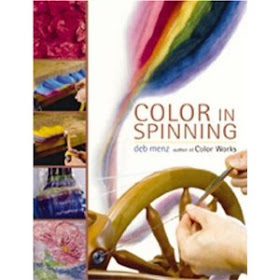 A few days prior to the meeting Rosalie emailed a questionnaire to everyone asking them to pick out one or two exercises from the book and to figure out what was needed in the way of fibre, dyes etc to perform the exercise.
A few days prior to the meeting Rosalie emailed a questionnaire to everyone asking them to pick out one or two exercises from the book and to figure out what was needed in the way of fibre, dyes etc to perform the exercise.At our first meeting in September the outline of the study group was set out – we would meet once a month – we even agreed on each date for the entire 9 months of the study – and we agreed to omit a meeting in December as everyone's frantic at that time.
Each person read the exercise out loud to the group and we had a short general discussion about what we felt the exercise entailed and we put a post-it note on the page. Surprising how often more than one of us had the same choice.
Since the book seemed to be set out sequentially, we decided to start at the first exercise chosen and give it to the month of October and so on through to the end of the book. Needless to say we are not coming anywhere close to covering every exercise in the book.
So my homework for the month of October was Chapter 1 exercises 17, 18 and 19.
Here is my take on exercise 17(a) Contrast of Saturation. Choose a colour and combine it with any of its tints, shades or tones in a single yarn. I chose periwinkle blue and blended it with black to create it's shade, then plied pure periwinkle with the shade.
 Exercise 17(b) Contrast of Saturation. Choose a colour then find another colour to make it brighter, and another to make it duller. I chose green, then added yellow to make it brighter and then purple to make it duller.
Exercise 17(b) Contrast of Saturation. Choose a colour then find another colour to make it brighter, and another to make it duller. I chose green, then added yellow to make it brighter and then purple to make it duller. Exercise 18 Contrast of Proportion. Choose several colours and combine them in Goethe’s proportions. Goethe assigned numbers to each colour and you combine proportionately. Yellow=3, Orange=4, Red=6, Violet=9, Blue=8, Green=6. My colours were violet, blue and green in the above proportions. This is a complete epiphany!
Exercise 18 Contrast of Proportion. Choose several colours and combine them in Goethe’s proportions. Goethe assigned numbers to each colour and you combine proportionately. Yellow=3, Orange=4, Red=6, Violet=9, Blue=8, Green=6. My colours were violet, blue and green in the above proportions. This is a complete epiphany! Exercise 19 Colour Harmonies. Create yarn using some of the colour harmonies. My first harmony was complementary , violet and green in equal proportions.
Exercise 19 Colour Harmonies. Create yarn using some of the colour harmonies. My first harmony was complementary , violet and green in equal proportions. Then I did a split complementary harmony and chose violet, green and red in equal proportions.
Then I did a split complementary harmony and chose violet, green and red in equal proportions.  My last harmony was a triad and I chose yellow, blue and red in equal proportions.
My last harmony was a triad and I chose yellow, blue and red in equal proportions. On the triad, you can truly see why yellow should be used in small amounts when blending colours for spinning; overpowering or what! I'm really looking forward to next month when we explore painting colour on roving.
On the triad, you can truly see why yellow should be used in small amounts when blending colours for spinning; overpowering or what! I'm really looking forward to next month when we explore painting colour on roving.
What a great idea for your study group. Please do keep posting your results.
ReplyDeleteRight, I must put that book on my wish list! I love having a context to really work through the design issues that come up all the time.
ReplyDeleteThis sounds like serious busines! I have the book at my shelf too, looked in it every once and a while but never realy worked with it. Like fiberGeek said, please do keep posting your results.
ReplyDeleteHappy spinning.
What great fun!!!! I'm so happy you're posting your results.
ReplyDeleteI'm not a spinner, but I found this very interesting nonetheless.
ReplyDeleteThanks!
I am not a spinner, but I found this post very interesting, and I think Goethe's rules can be applicable to me in designing weaving, too.
ReplyDeleteI also brought this post to my Fiber Arts Guild, as we do have many spinners, and the challenge for this month was for everyone, spinners and non-spinners alike, to bring in one new-to-them bit of spinning info.
Thanks!
I am very interested in your colour study. I have been encouraging our guild to look into the best use of colour combinations, along the lines of 'Colour Me Beautiful'. My reason being, it takes a long time to dye, spin and create a hand spun knitted or woven item and it might as well be one that you feel your best wearing and will be worn often.
ReplyDeleteI will follow with interest your next study. I have been dyeing woollen tops and making my own study of creating different yarns using rainbow dyed lengths, carded or plied with self or complementary colours.
Have fun, Maggie
How great to see the summaries of your color exercises so far. Thanx for posting them. Our next get-together should be very exciting as each spinner seems to be coming up with terrific interpretations of the exercises. Without a doubt, it's turning out to be an exhilerating study for us all.
ReplyDelete